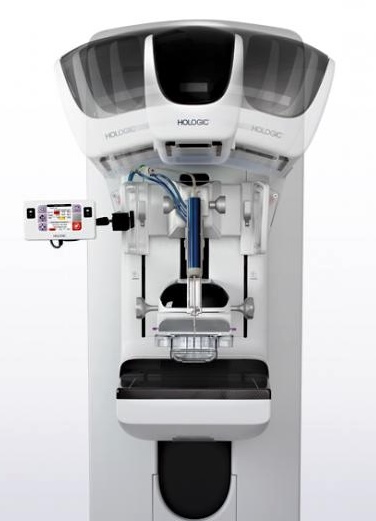![]()
During a breast biopsy, a board-certified physician draws a small tissue sample from the breast with a needle. A pathologist then examines the sample of breast tissue for irregularities.
Premier Diagnostic Imaging offers two types of breast biopsies at our updated and expanded Center for Women, a core needle biopsy and a stereotactic biopsy.
Both types of biopsies are outpatient procedures.
Your doctor might request a breast biopsy if you feel a breast lump or if your mammogram shows abnormal tissue. A biopsy is the best method to determine if the tissue is harmless (benign) or cancerous (malignant).
One in eight women will develop breast cancer during their lifetime. Roughly 85% of breast cancers occur in women with no family history of breast cancer. Early detection is key to a more favorable prognosis and outcome. The biopsy is part of the detection process.
Roughly 80% of women who have a biopsy receive good news. A request for a biopsy doesn’t mean you have breast cancer.
Biopsy procedures differ depending on individual scenarios, like the size of the anomaly or lump and location. Premier Diagnostic Imaging performs ultrasound-guided core needle biopsy procedures and stereotactic breast biopsies.
Preparation for a breast biopsy is simple. Notify your doctor about any medications you take, including herbal supplements. Also, tell them if you have had a recent illness or if you are pregnant.
Wear loose clothing and remove jewelry. Avoid wearing deodorant, lotions, or perfumes under your arms or near your breasts.
The experiences of undergoing a core biopsy or stereotactic biopsy are similar. The main difference is how your physician locates the area to be examined.
Core biopsies are guided by ultrasound. Stereotactic biopsies are guided by a special mammogram machine. The machine calculates the exact location of the abnormality based on x-rays taken from different angles.
Both procedures use a hollow needle and a vacuum-assisted device to extract a tissue sample from your breast. You will receive local anesthesia to numb the area and help prevent discomfort.
During a core biopsy, you will lie still on your back on the table during the procedure. The radiologist might apply a gel-like substance to the biopsy area. The gel helps the hand-held ultrasound transducer locate the lump or suspicious area.
The radiologist will insert the needle into the breast. A vacuum attached to the needle withdraws fluid or cellular clusters into the needle for examination. Obtaining the tissue/fluid sample takes about 15 seconds.
You’re done! The procedure from start to finish usually takes 15 to 30 minutes.
During a stereotactic biopsy, you will either be placed in a sitting upright position or lay on your side, depending on optimal positioning for target area sampling. Your breast will be placed in compression similar to your mammogram exam. The machine takes images to be reviewed by your radiologist.
Once the radiologist verifies the area, the computer generates exact coordinates. Your physician will make a small nick in your skin and insert the tip of the needle. The needle is advanced the rest of the way to the biopsy site using computer-generated coordinates. Like a core biopsy, a vacuum-assisted device draws sample material into the needle. Several samples may be taken. Also, a small marker may be placed at the site for future reference.
The procedure from start to finish usually takes about an hour.

The core needle and stereotactic biopsies are less invasive than a surgical biopsy. The procedures result in minimal to no scarring. Slight bruising or tenderness might occur following the procedure.
Over-the-counter pain relievers or a cold compress may help the discomfort. You will receive instructions for aftercare when the test is over.
Avoid strenuous activity and heavy lifting for 24 hours after the procedure. Tell your doctor if you notice excessive swelling, drainage, or heat on the surface of the breast.
A pathologist will review the biopsy sample and send it to your health care provider within 5-7 business days. From there, your doctor will discuss the results with you directly. Follow further recommendations for care based on your diagnosis and prognosis.
American Cancer Society: https://www.cancer.org/cancer/breast-cancer/screening-tests-and-early-detection/breast-biopsy/fine-needle-aspiration-biopsy-of-the-breast.html
Breastcancer.org https://www.breastcancer.org/symptoms/understand_bc/statistics
National Breast Cancer Foundation: https://www.nationalbreastcancer.org/breast-cancer-biopsy
Johns Hopkins Medicine Medicine https://www.hopkinsmedicine.org/howard_county_general_hospital/services/breast_health/types_of_breast_biopsy.html
For more detailed information on any of the biopsies
offered by Premier Diagnostic Imaging, Email or Call Us at (931)-528-1800.